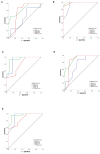Screening for Cognitive Impairment After Stroke: Validation of the Chinese Version of the Quick Mild Cognitive Impairment Screen
- PMID: 33763012
- PMCID: PMC7982853
- DOI: 10.3389/fneur.2021.608188
Screening for Cognitive Impairment After Stroke: Validation of the Chinese Version of the Quick Mild Cognitive Impairment Screen
Abstract
Background: Screening for post-stroke cognitive impairment (PSCI) is necessary because stroke increases the incidence of and accelerates premorbid cognitive decline. The Quick Mild Cognitive Impairment (Qmci) screen is a short, reliable and accurate cognitive screening instrument but is not yet validated in PSCI. We compared the diagnostic accuracy of a Chinese version of the Qmci screen (Qmci-CN) compared with the widely-used Chinese versions of the Montreal Cognitive Assessment (MoCA-CN) and Mini-Mental State Examination (MMSE-CN). Methods: We recruited 34 patients who had recovered from a stroke in rehabilitation unit clinics in 2 university hospitals in China: 11 with post-stroke dementia (PSD), 15 with post-stroke cognitive impairment no dementia (PSCIND), and 8 with normal cognition (NC). Classification was made based on clinician assessment supported by a neuropsychological battery, independent of the screening test scores. The Qmci-CN, MoCA-CN, and MMSE-CN screens were administered randomly by a trained rater, blind to the diagnosis. Results: The mean age of the sample was 63 ± 13 years and 61.8% were male. The Qmci-CN had statistically similar diagnostic accuracy in differentiating PSD from NC, an area under the curve (AUC) of 0.94 compared to 0.99 for the MoCA-CN (p = 0.237) and 0.99 for the MMSE-CN (p = 0.293). The Qmci-CN (AUC 0.91), MoCA-CN (AUC 0.94), and MMSE-CN (AUC 0.79) also had statistically similar accuracy in separating PSD from PSCIND. The MoCA-CN more accurately distinguished between PSCIND and normal cognition than the Qmci-CN (p = 0.015). Compared to the MoCA-CN, the administration times of the Qmci-CN (329s vs. 611s, respectively, p < 0.0001) and MMSE-CN (280 vs. 611s, respectively, p < 0.0001) were significantly shorter. Conclusion: The Qmci-CN is accurate in identifying PSD and separating PSD from PSCIND in patients post-stroke following rehabilitation and is comparable to the widely-used MoCA-CN, albeit with a significantly shorter administration time. The Qmci-CN had relatively poor accuracy in identifying PSCIND from NC and hence may lack accuracy for certain subgroups. However, given the small sample size, the study is under-powered to show superiority of one instrument over another. Further study is needed to confirm these findings in a larger sample size and in other settings (countries and languages).
Keywords: China; Qmci-CN; cognition screen; mild cognitive impairment; post-stroke dementia; stroke.
Copyright © 2021 Xu, Yi, Lin, Peng, Wang, Lin, Chen, Zhang, Deng, Guo, Shi, Wang, Molloy and O'Caoimh.
Conflict of interest statement
DM and RO'C are co-copyright holders of the Qmci screen. DM, RO'C, and YX are copyright holders of the translation into Chinese, the Qmci-CN screen. The remaining authors declare that the research was conducted in the absence of any commercial or financial relationships that could be construed as a potential conflict of interest.
Figures

Similar articles
-
MoCA and MMSE for the detection of post-stroke cognitive impairment: a comparative diagnostic test accuracy systematic review and meta‑analysis.J Neurol. 2025 May 18;272(6):407. doi: 10.1007/s00415-025-13146-5. J Neurol. 2025. PMID: 40383729
-
Screening for Cognitive Frailty Using Short Cognitive Screening Instruments: Comparison of the Chinese Versions of the MoCA and Qmci Screen.Front Psychol. 2020 Apr 3;11:558. doi: 10.3389/fpsyg.2020.00558. eCollection 2020. Front Psychol. 2020. PMID: 32308636 Free PMC article.
-
Comparison of the Quick Mild Cognitive Impairment (Qmci) screen to the Montreal Cognitive Assessment (MoCA) in an Australian geriatrics clinic.Int J Geriatr Psychiatry. 2017 Jun;32(6):643-649. doi: 10.1002/gps.4505. Epub 2016 Jul 18. Int J Geriatr Psychiatry. 2017. PMID: 27427212
-
Validation of the Dutch version of the quick mild cognitive impairment screen (Qmci-D).BMC Geriatr. 2015 Oct 2;15:115. doi: 10.1186/s12877-015-0113-1. BMC Geriatr. 2015. PMID: 26431959 Free PMC article.
-
Is the Quick Mild Cognitive Impairment Screen (QMCI) more accurate at detecting mild cognitive impairment than existing short cognitive screening tests? A systematic review of the current literature.Int J Geriatr Psychiatry. 2019 Dec;34(12):1739-1746. doi: 10.1002/gps.5201. Epub 2019 Aug 22. Int J Geriatr Psychiatry. 2019. PMID: 31418473
Cited by
-
MoCA and MMSE for the detection of post-stroke cognitive impairment: a comparative diagnostic test accuracy systematic review and meta‑analysis.J Neurol. 2025 May 18;272(6):407. doi: 10.1007/s00415-025-13146-5. J Neurol. 2025. PMID: 40383729
-
Validation of the Quick Mild Cognitive Impairment Screen in an American Sample of Patients With Mild Cognitive Impairment and Mild Dementia.Int J Geriatr Psychiatry. 2024 Nov;39(11):e70026. doi: 10.1002/gps.70026. Int J Geriatr Psychiatry. 2024. PMID: 39586819
-
Diagnostic accuracy, reliability, and construct validity of the German quick mild cognitive impairment screen.BMC Geriatr. 2024 Jul 18;24(1):613. doi: 10.1186/s12877-024-05219-3. BMC Geriatr. 2024. PMID: 39026157 Free PMC article.
-
Editorial: Update on Vascular Contributions to Age-Related Neurodegenerative Diseases and Cognitive Impairment - Research of ISNVD 2020 Meeting.Front Neurol. 2021 Nov 11;12:797486. doi: 10.3389/fneur.2021.797486. eCollection 2021. Front Neurol. 2021. PMID: 34858320 Free PMC article. No abstract available.
-
A comparison of electronic and paper versions of the Quick Mild Cognitive Impairment (Qmci-CN) screen.J Alzheimers Dis Rep. 2025 May 30;9:25424823251343810. doi: 10.1177/25424823251343810. eCollection 2025 Jan-Dec. J Alzheimers Dis Rep. 2025. PMID: 40452776 Free PMC article.
References
-
- Chinese Stroke Association . Post-stroke cognitive impairment management expert committee. Expert consensus on Post-stroke cognitive impairment management. Chin J Stroke. (2017) 12:519–31. 10.3969/j.issn.1673-5765.2017.06.011 - DOI
LinkOut - more resources
Full Text Sources
Other Literature Sources

